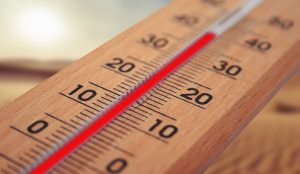Climate Fair Share approach: Who is responsible for climate change?

Over a century of industrialization and massive use of natural resources brings consequences. Global warming, water scarcity, and other environmental issues are seriously affecting the planet. In this context, many organizations and entities are trying to find solutions towards creating a better future. The secret lies in finding innovative and sustainable ways to support life and ensure a healthy environment for the generations to come. But who is responsible for climate change and the issues it generates? While we all share responsibility at some level, there are things we can do to establish clear duties at institutional and governmental levels.
What is climate change?
Although these words are widely known, it’s better to establish what we talk about when discussing climate change.
The average temperature on the surface of the Earth has increased by 1.7° Fahrenheit since 1880. This presents a larger problem than it seems. As an example, the heat emitted by human activity equals the heat produced by 400,000 Hiroshima bombs exploding every day. This is a disturbing fact in and of itself.
Future generations are in big trouble while the temperature on the planet keeps rising. This will generate longer drought periods, higher temperatures, and more intense storms in between. Such a scenario can lead to nothing good. We are facing a future of massive amounts of refugees, the extinction of most species on Earth, and the melting of polar ice caps. Most of today’s coastal cities will be underwater in such a scenario.
The problem: What causes climate change?
The effects of global warming on the planet are disturbing. Only in 15 years (from 1990 to 2005) the gas emissions derived from human activity increased by 26%. Most of this was caused by a rise in carbon dioxide concentrations in the atmosphere. Without a doubt, the main cause for climate change is human activity and, unless measures are taken, the perspectives for a future are frightening. Next is a list of factors that contribute to this phenomenon.
Power Plants
Most of the electrical emissions in the US are derived from burning coal. This is an alarming fact if we consider that, in a country like the US, 40% of the carbon dioxide emissions come from this industry. Moreover, two-thirds of mercury emissions are generated by coal plants and waste incineration.
Not Enough Mitigation
Online businesses can contribute to mitigating climate change when compared to traditional brick-and-mortar stores in several ways. First, they often have smaller physical footprints, reducing the need for large commercial spaces and their associated energy consumption. Additionally, online businesses can optimize their supply chains, reducing transportation emissions by utilizing more efficient delivery routes and methods. Furthermore, e-commerce encourages the digitization of processes, reducing paper usage and energy consumption related to physical documentation. States such as New Jersey, allow best online casinos NJ to be accessible via the Internet instead of requiring physical presence and thus contribute heavily to our local sustainability. These factors collectively demonstrate how online businesses can make strides toward a more sustainable and eco-friendly future.
Transportation
Far from being a small part of the problem, transportation is one of the key factors. In many countries, this is the primary source of carbon dioxide emissions. Taking the US as a reference again, we see that transportation accounts for 29.3% of emissions while electrical power for 28.3%. This 29% is generated mostly by cars and SUV trucks, i.e., vehicles used for public transportation. This is why decarbonizing urban transportation becomes important.
Farming

Industrial farming activities release high levels of carbon dioxide and methane into the atmosphere. They are also one of the main causes of deforestation and soil contamination. This is a consequence of planting the same crop over and over on the same piece of land.
Deforestation
This is one of the key factors contributing to global warming. It affects the carbon dioxide levels in the atmosphere in two ways. On one hand, the process of felling rises the level of emissions in and of itself. On the other hand, with the reduction of forests, there are fewer trees to capture carbon dioxide. The video below explains the alarming situation showing vast deforested areas across the planet.
Fertilizers
By utilizing nitrogen-rich fertilizers, the agricultural industry is accountable for 62% of nitrous oxide released into the atmosphere. These fertilizers increase the amount of heat a land can store. Moreover, Nitrogen oxide traps 300 times more heat than carbon dioxide.
Oil extraction
Burn-offs from oil extraction releases carbon dioxide. The drilling, processing, and distribution of fossil fuel is responsible for approximately 80% of the carbon dioxide contamination. It also produces alarming levels of methane pollution.
Extraction of natural gas
The burning of natural gas releases fewer contaminants and generates less levels of carbon dioxide. Nonetheless, the gas drilling process causes massive pollution. It’s worth noting that the hydraulic extraction technique pollutes groundwater sources. Since many areas depend solely on this source for water, this can bring many environmental issues.
Permafrost
Experts estimate that there are nearly 500 gigatons of carbon trapped only in the Siberian permafrost. If we consider that one gigaton equals one billion tons, we see there’s a problem. When these melt they release greenhouse gases thus speeding up the melting of more permafrost. This is a vicious cycle generating more heat and releasing a larger amount of carbon into the atmosphere.
Waste
Both waste disposal and treatment are dangerous for the environment. The trash breaking down in landfills releases nitrous oxide and methane. 18% of methane gas in the atmosphere comes from this source.
Volcanic Eruptions
Although volcanos release carbon dioxide at the moment of the eruption, they don’t have a large impact on climate change. On the contrary, they counteract the effect by releasing ash. This reflects solar energy and generates a short-term cooling effect.
What is climate fair share?

Although the problem reaches every one of us at every corner of the Earth, some parties have more responsibility in the matter. For example, some countries have contributed to climate change more than others. Some of them have a greater array of resources to put up the fight that the planet needs. The wealthiest, most powerful, and industrialized countries thus have a larger responsibility towards solving the climate change issue.
But how do we establish such levels of responsibility? Which countries should allocate larger budgets and get more involved in the processes? It becomes necessary to quantify a country’s ‘fair share’ of action. Thus, the project is based on a set of premises around which it’s possible to analyze and set demands. Consequently, a country or entity can set up the necessary mechanisms to implement plans and assess results. Over the past ten years, these parameters have been developed by the Climate Equity Project in the US. Thus, it would be possible to create a rating evaluating a government’s efforts against what is considered its “fair share” of responsibility.
There are yet no agreed guidelines to set this ranking, but the initiative represents an important advance. The Paris Agreement, in its article 4.3, contemplates the different levels of contributions and considers the country’s capabilities realistically. According to this, governments are expected to justify their taken measures against global warming.
Thanks to the Paris Agreement, governments must present reports reflecting their efforts and these must be revised regularly. The NDCs (Nationally Determined Contribution) are thus updated and improved.
But it becomes necessary to establish the parameters to define ‘fair share’ and ensure everyone is putting in their best effort. There are many proposals to establish this rating and one of them is the CAT (Climate Action Tracker). Based on scientific literature, the CAT intends to define clear parameters to implement the Paris agreement. It was created by an independent group of scientists, who supplemented information gaps through their own analysis.
The CAT method
To establish ‘fair’ parameters it’s necessary to consider the points of view of governments and their interests. Some argue that those nations that have contributed more to climate change should collaborate more. In line with this, developed countries have a larger share of responsibility because have fewer economic and social issues to resolve. It doesn’t seem realistic to ask third-world countries to allocate extensive budgets for this purpose.
The CAT team based its research on effort-sharing studies. These include more than 40 countries, newly published studies, and, like we stated above, their own analysis. This data covers different viewpoints of what may be considered ‘fair’ including capability, equality, and historical contribution to global warming. The analysis covers both the Paris agreement, with its 1.5° limitation, and the former goal of 2°. A historical perspective is necessary to implement long-term objectives.
- Step 1: Create a ‘fair range’ for every nation according to the existing scientific literature.
- Step 2: Make sure all the viewpoints are equally considered through a weighting system.
- Step 3: These fair share guidelines are chosen as the inner 90% for the study distribution.
- Step 4: Divide the range into sections considering the same level for every country.
Thanks to this method, it’s possible to define each country’s share of historic responsibility and determine emission conditions for future years. Each level corresponds to the achieved temperature goals if the other parties would implement the required measures according to their position in the rating. This is called the ‘ambition level’.
Finally, we can define which levels of ambition contribute to the rise of global temperature according to the Paris Agreement.
CAT’s assessment table
This is the assessment table presented by the CAT project:
- Compatible with the Paris Agreement (1.5°)
- Compatible with the 2° standard
- Insufficient
- Highly insufficient
- Critically insufficient
If all governments would reach a ‘Paris Agreement’ level, global warming should be kept below 2°C (around 1.6 over the rest of this century and two-thirds of a chance of staying at 1.5°C in the 22nd century). This is the optimal performance.
The next point is when a country reaches a 2°C compatibility. This means that with these levels of emissions, there’s a two-thirds of a chance that the warming will be below 2°C by the end of the 21st century.
If a country ranks as ‘insufficient’, it means that even though some advances have been made, they are not sufficient to keep global warming below 2°C unless other governments do significantly more than their ‘fair share’ to compensate.
Highly insufficient means that, if all players fall into this category, the warming level will be above 3°C and below 4°C.
Finally, critically insufficient points to a warming of 4°C by the end of the century.
In some cases, the optimal level of fair contribution for some governments would mean steep emission reduction, reaching a level of less than zero towards the next decade. If this cannot be achieved in the country itself, the government is responsible for compensating abroad. In other words, financing climate projects beyond its borders.
Nonetheless, the fair share approach is based solely on reducing the impact caused by fossil fuel combustion, agriculture, waste, and industry. It doesn’t take into consideration the LULUCF (Land Use, Land-Use Change and Forestry).
Why the LULUCF sector can’t be included in the CAT equation
The Climate Action Tracker method is focused on reducing CO2 and GHG emissions deriving from the sources described above. These account for 93% of the emissions if we considered statistics from 2010.
On the other hand, emissions from the LULUCF sector account for only 7%. While these have a significant impact on global temperature rise, they weren’t included in the analysis and calculations due to several factors.
- Due to their large portion of the total emissions, it becomes imperative to focus on fossil fuel burning, agriculture, waste, and industry to maintain the warming at 1.5° or less.
- The LULUCF emission data presents high uncertainty levels.
- We must be able to compare actions between similar NDCs and LULUCF presents diverse approaches.
- The setting of goals must be transparent and adequate.
- Methodological limitations since most fair share studies are based on GHG emissions excluding the LULUCF sector.
Finally, to achieve the goal of 1.5°C and 2°C, it’s necessary to implement decarbonization, especially from the said industries. Long-lasting changes must be implemented in the energy industry and industry in general to reduce greenhouse emissions. What happens in the LULUCF sector doesn’t change this fact.
Fair share assessment categories
Some of the largest world powers argue that they are already doing their share and justify their position by comparing themselves to countries like India, or China. While it’s true that these economies have flourished in the last decades and are now emitting high levels of contamination, they are not considered significant historical contributors.
Rich countries have been releasing emissions for over a century and this is a historical weight that must be considered. Since global warming is a cumulative phenomenon (vicious cycle), this factor can’t be ignored.
The climate share method establishes the level of action to be taken based on the following:
Remaining carbon budget: The total amount that may still be emitted before the planet reaches an irreversible warming point.
Country’s responsibility: This is based on the number of emissions throughout the country’s history.
Country’s capability: This point considers the capability of a government and its possibilities to implement actions.
Country’s rights: Each country has the right to develop sustainably and ensure the best climatic conditions for its future citizens.
The carbon budget
The scientific community has concluded that humans must keep the global temperature rise below 1.5°C. This is considered the ‘point of no return’. If we cross this threshold, we would be facing major climate crises. Warming levels would increase beyond control possibly causing the extinction of mankind.
Even a minor temperature change is dangerous. A 1.1 increase is already affecting the lives of many communities, mostly those who haven’t contributed to the damage in the first place.
When carbon is released into the atmosphere, there’s a time gap before it contributes to the temperature rise. So, if we emit carbon today, there is a level of warming locked in that will impact the global temperature later on. There’s also the economic factor and the time it takes to design and implement strategies and restructure a country’s economy.
Hence, there is a limited amount of carbon we are allowed to emit before reaching a critical point. This is what we called the ‘carbon budget’.
Country’s Responsibility
Some nations have been contributing to global warming for nearly two centuries. It’s only logical that these governments have a higher degree of responsibility in taking action.
Country’s Capability
Countries like the US, the UK, Australia, and many other European nations have grown rich and comfortable thanks to their industries, releasing massive emissions. Hence, these have a larger level of both responsibility and capability to implement climate-change plans. This is what we call ‘equity’.
Country’s rights
The global south has many regions that are the least responsible for global warming. They are also some of the most affected areas and have few resources to deal with the climate crisis. Yet, they still have the right to develop sustainably and provide a healthy environment for their citizens. Under these circumstances, it’s only fair that the most responsible countries provide financial aid for climate change and sustainability actions.
What countries are doing their fair share?
The CAT method also helps us to assess results and determine who is doing their fair share and who is not. The results may be surprising.
Even though the EU claims to be one of the leaders in climate change action, they are far from complying with their fair share. This jurisdiction is responsible for most of the historical emissions and has the scientific and financial capabilities to effectively take action.
China, on the other hand, is doing much more than its fair share. Often blamed as the largest emitter of greenhouse gases today, this country doesn’t have the same historical responsibility as some of the western economic powers. The PRC is broadly complying according to its level of responsibility and capability.
Moreover, many of its emissions come from factories producing goods to be exported, for example, to the US and Europe. Hence, they are responsible for these emissions too. This is called an ‘embedded emission’.
Conclusion
The climate crisis is taking major dimensions, and it can lead us directly to extinction. This calls for an urgent restructuring of the production, energy, and industry sectors towards sustainability.
This is arguably the only environmental issue that affects absolutely everyone on the planet. Rich and poor countries developed and undeveloped economies, all cultures and peoples are affected by climate change.
While everyone needs to do their part, certain nations have a higher level of responsibility in the matter. They also have the resources to implement effective measures. It’s only fair that these governments have a larger share of the responsibility.
Approaches like the Climate Action Tracker intend to fairly establish the share of each country when it comes to achieving sustainability. The ultimate goal is to reach a level of temperature rise of no more than 1.5°C towards the end of this century.
Based on scientific analysis, such methods give us the tools to assign milestones, establish clear goals, and assess results most fairly.